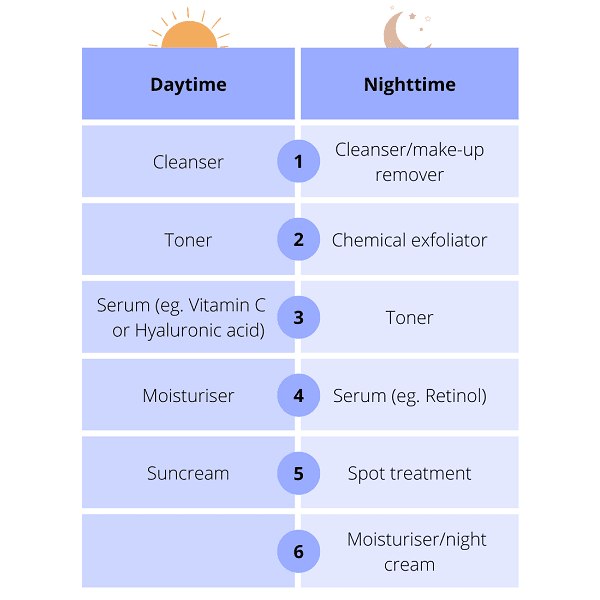With so many skincare products on the market, it can be hard to know what order in which to apply them. It’s important to know the difference between these and at what point in your routine enhances their effects most. This can ensure your skin is kept looking and feeling its best. Read on to discover the best skincare routine order, for day and night.
Does Skincare Routine Order Matter?
In short: yes. The order in which you apply your products alters how well your products are absorbed into your skin, and therefore how well they work on your skin. For example, the right routine can improve hydration, texture, tone, signs of ageing and reduce risk of sun damage.
With age, skin becomes thinner, and loses the hydration, fat and plump appearance associated with youth. You may notice a change in texture, and the development of wrinkles or loose skin.
This skin ageing process occurs due to a variety of reasons. For example, through a reduction in oestrogen levels, especially during the menopause. A build-up of inflammation and free radicals can also cause damage to skin cells. Prolonged exposure to ultraviolet (UV) light from the sun and pollution can further accelerate ageing (1).
Therefore, creating a skincare routine that considers these factors can ensure we are allowing our skin to age gracefully.
Daytime vs. Nighttime Routine: Is There a Difference?
There may be many similarities between your daytime and nighttime skincare routine order. However, the function of these routines differs.
In the daytime, your skin is needing protection and prevention of damage from environmental stressors such as the sun and pollution. At nighttime, without these stressors, your routine can focus more on skin repair and products that are sensitive to sunlight.

Daytime Skincare Routine
- Cleanser
- Toner
- Serum
- Moisturiser
- Suncream
Step 1: Cleanser
Opt for either a water-based cleanser, oil-based, or both! Water-based cleansers work well for giving a deep clean, and for those with oily, blemish-prone skin. On the other hand, oil-based cleansers work well for removing excess sebum and leftover make up, and for those with dry or sensitive skin. If you are opting for a “double cleanse” method, use the oil-based cleanser first, followed by the water-based cleanser to keep oiliness at bay.
Step 2: Toner
Toners remove the last traces of cleanser, dirt, oil and make up. They cleanse the pores and refresh the skin in preparation for the next steps.
Step 3: Serum
Sun-stable serums, such as vitamin C (for brightening and collagen production) or hyaluronic acid (for moisturisation and scar reduction) work well for a daytime skincare routine.
Step 4: Moisturiser
Choose a light option to nourish and hydrate your skin throughout the day without looking greasy.
Step 5: Suncream
An SPF is essential within your daytime skincare routine to protect your skin from harmful UV radiation throughout the day. UV radiation can lead to signs of premature ageing, sun damage and skin cancer (2).
Nighttime Skincare Routine
- Cleanser/make-up remover
- Chemical exfoliator
- Toner
- Serum
- Spot treatment
- Moisturiser/night cream
Step 1: Cleanser/Make-up Remover
Nighttime is another opportunity to try the “double cleanse” method, or simply opt for an oil-based cleanser or make-up remover to remove the make-up, pollution and suncream of the day.
Step 2: Chemical Exfoliator
Both physical and chemical exfoliators scrub away dead skin cells to leave your skin looking fresh and smooth. However, chemical exfoliators have been found to be gentler and have a reduced risk of the skin damage sometimes associated with physical exfoliator options. Using these at night reduces photosensitivity during the day. Popular choices include glycolic acid and salicylic acid.
Step 3: Toner
Remove the final traces of the day with a refreshing, cooling toner.
Step 4: Serum
Nighttime is the perfect time to use serums that may increase skin sensitivity during the daytime, in sunlight. Retinol and retinoids work to increase cell turnover, reducing the appearance of fine lines while firming the skin (3).
Step 5: Spot Treatment
If you suffer with acne, applying a spot treatment at night can reduce the appearance of breakouts for the following day. Daytime application may reduce effectiveness if you are covering the spot with make-up.
Step 6: Moisturiser: Night Cream
Thicker, more nourishing moisturising creams can be used at nighttime, to repair the skin and leave it feeling hydrated and plump the following day.
Top Tips
Tip 1: Use The Right Products For You
Find the right products for your skin type. Not every skin needs a retinoid, and not every skin fairs well with oil-based cleansers. Do some experimentation to find exactly what works for you, or see a dermatologist for the best recommendations.
Tip 2: Always Moisturise
Moisturise day and night, even if you have oily skin. Often, the culprit of our skin issues is a damaged skin barrier. Daily moisturisation can help to repair the barrier and reduce many common skin problems, including reducing excess sebum production.
Tip 3: Look After Your Skin From The Inside Out
Eat your skincare. Healthy skin not only comes from the products you use, but also from how you look after your skin from the inside out. Incorporate plenty of healthy fats from fish, avocados, olive oil, nuts and seeds, and a variety of vitamins and antioxidants from fruits and vegetables. Supplements are a quick and easy way to incorporate vitamins and minerals into your diet.









